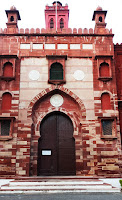 |
| Victoria Gate AMU |
The life of Sir Syed Ahmad Khan and a brief history of Aligarh Muslim University Aligarh (AMU)
The
Aligarh Muslim University Aligarh is one of the top ranked Universities of
India, the University is located in UP’s magnificence city ‘Aligarh’. Sometimes
it is referred to as ‘Mecca of Higher Education’, and the city offered more than
60 amazing heritage visiting sites including the University’s world class
buildings.
1. About the University
The
social, economic, and educational condition of Indian Muslims has been very
poor for centuries. Education is one the most important weapons for the
development and empowerment of any marginalized community. Though, neither the
Muslim rulers nor the British government ever paid any attention to this
condition of the Muslims. Hence, Sir Syed Ahmad Khan observed the situation and
condition of Muslims and he intended to establish an educational institution
for the empowerment of Indian Muslims, which they survived in the mainstream
society.
On 24th May 1875, Sir Syed Ahmad Khan inaugurated a school (Madarsatul Uloom), later on 8th November 1877, Lord Lytton, the Viceroy and Governor General of British India laid the foundation stone of Muhammadan Anglo-Oriental (MAO) College. The college turned to the central university called Aligarh Muslim University Aligarh (AMU) in 1920 through an Act called AMU Act, 1920 which falls in the seventh schedule of the Indian Constitution. The main campus of University is located in Aligarh city and spread over the total area around 467.6 hectares. It has three off-campus centers as AMU Malappuram (Kerala), Murshidabad (West Bengal), and Kishanganj (Bihar). The University offers more than 300 courses including the traditional, modern, and technical branches of education. Aligarh Muslim University Aligarh has consistently ranked among the best educational institutions not only in India but also the worldwide ranked. Alumni of the University are referred as Alig or Aligarian.
 |
| Sir Syed's potrait |
2. Biography of Sir Syed Ahmad Khan: He was a famous Islamic reformer, philosopher, educationist, scholar, and the founder of great institution Aligarh Muslim University Aligarh (AMU). Sir Syed Ahmad Khan was born during the reign of Mughal emperor Akbar II (1806-1837) on 17th October 1817 in Delhi, and died on 27th March 1898 at Aligarh, India. His father’s name was Mir Muttaqi and mother’s name was Azizun Nisha. He married with Parsa Begum and had two sons whose names were Syed Hamid and Syed Mahmud. As a socio-religious reformer, he want the people of India to study both Science and English along with traditional study. He also said,
“The main purpose of this institution is to impart modern education to Muslims who are suffering because of lack of it but this institution is for all, Hindus and Muslims alike. Both of them need education.”
Top 10 visiting places of Aligarh Muslim University Aligarh (AMU)
 |
| Jama Masjid AMU |
 |
| Bab-e-Syed Gate AMU |
 |
| Sir Syed House |
6. Sir Syed House AMU:
It is a place
where Sir Syed Ahmad Khan stayed more than two decades, now better known as Sir
Syed Academy. The house was renovated and converted to the Sir Syed Memorial
House generally known as “Founder House.”
 |
| Maulana Azad Library |
7. Maulana Azad
Library AMU: It is the central library of Aligarh
Muslim University, Aligarh. It was built more than 100 years before, which is
surrounded by 1.92 hectares of area with its lawns and gardens. First it was
named Lytton Library, because of Lord Lytton laid the foundation stone of the
library at the time of establishment of MAO College in 1877. Later, in 1960 it
was inaugurated by Jawaharlal Nehru who was the first Prime Minister of India.
After the augural session the Library renamed in the name of Maulana Azad (the
first Education Minister of India) and known as Maulana Azad Library. It is an
Asia’s largest University Library with seven storey building, and it has more
than 18 lakhs books.
9. Musa Dakri Museum AMU: The Museum is situated in the heart of University’s campus near the Kennedy Auditorium and in front of Arts Faculty, AMU. The Museum is the part of Cultural Education Centre (CEC) AMU, Aligarh.
10. Jawaharlal Nehru Medical College AMU: It is the constituent medical college, which is located in the main campus of Aligarh Muslim University Aligarh, India. It is one of the oldest Medical Colleges of the country, was established in the year 1961, and recognized by the National Medical Commission (NMC). Medical college commonly known as JNMC Aligarh and it has a big Trauma Centre for emergency and accidental casualties, and OPD is conducted as daily basis for the general patients, and has a separate Gynaecology department for pregnant women. Jawaharlal Nehru Medical College Aligarh offers admission through NEET in medical stream at the Undergraduate (UG) and Postgraduate (PG) levels, and has an annual intake 150 UG (MBBS) and 146 PG seats in all the fields of medicine.











0 Comments
Please do not enter any spam link in the comment box.